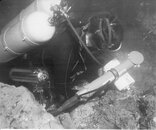CuzzA
Wetwork for Hire
It's coming in your state.no seatbelt law in my state.....i still wear one.....
neither did seatbelts.
And the law is based on data showing not wearing a seat belt will likely lead to death and injury in a car accident.
Not doing a safety stop will not likely lead to being bent. It's a very poor analogy.
But it's a good practice to teach for the masses where age, fitness and skills are not considered. In other words, it relieves the training agencies of having to consider those three things. 60 years old, out of shape and poor buoyancy control? Not to worry, as long as you do your safety stop it's extremely unlikely you'll get bent.




